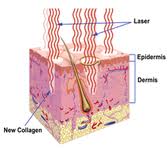Facial laser resurfacing has evolved over the past twenty years from in both how the energy is delivered to what depths into the skin that is treated. When initially introduced laser resurfacing was known as ‘fully ablative’, meaning that at any energy level it treated 100% of the skin’s surface. While many of the results a fully ablative laser resurfacing treatment creates can be impressive in the amount of wrinkle reduction and skin tightening, it can be associated with loss of skin pigment and long healing and recovery times.

The theoretical benefits of fractional laser resurfacing is that these deeper penetrating columns of laser light cause at least an equal amount of increased collagen formation and skin tightening as that of more superficial fully ablative laser treatments. This would seem to make perfect sense given the greater depth of dermal injury and it has always been assumed to be true. It also accounts for its popularity as a widely used treatment.
In the October 2012 issue of Dermatologic Surgery, a human study was done to directly compare the molecular changes that result from fractional vs fully ablative carbon dioxide (CO2) laser resurfacing in skin damaged skin. In 34 adults with substantial facial skin damage, matched facial areas with treated between the two laser types. Real-time reverse transcriptase polymerase chain reaction technology and immunohistochemistry were used to quantify molecular responses to each type of laser treatment. Their results show that both fully ablative or fractional laser resurfacing resulted in significant skin changes of dermal remodeling and the creation of new collagen. After one treatment, however, fractional laser resurfacing effects were only about half of that seen by a fully ablative treatment. The fully ablative laser treatments created greater changes with more pronounced collagen formation.
What this study indicates is that the fractional laser approach is not superior to fully ablative treatments (in a single treatment) as many may believe or purport that it is so. This is no surprise given that much less skin surface is treated, often 78% to 95% less. The value of fractional laser resurfacing is that it has less risks of skin problems particularly in patients with more natural skin pigment.Whether better skin results, particularly in its tightening effect, may occur with repeated treatments can not be determined from this one study. The value of fractional laser resurfacing is that such repeated treatments can be safely done.
Dr. Barry Eppley
Indianapolis, Indiana


